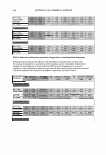404 JOURNAL OF COSMETIC SCIENCE At appropriate concentrations, the cylindrical micelles pack into hexagonal array to produce a liquid crystal phase that is a clear ringing gel. This gel formed the basis of brilliantine hairdressing. Increase in the packing factor to values greater than 0.5 causes the molecules to pack into planar arrays - this is lamellar liquid crystal. Lamellar liquid Lamellar Liquid Crystals P.1cking factor ,·/al e = 1 crystal is a lubricant due to the plane of slippage within the layers. The mutual repulsion between the layers confers a shear-thinning rheology with yield stress (Ellis rheology) on this phase. Lamellar liquid crystal is a useful stabilizing phase for oil-in -water emulsions and it has been used for this purpose to stabilize skin lotions against separation. In the liquid crystalline state, the hydrophobic tail groups of the emulsifier molecules display liquid-like mobility. If the temperature is lowered sufficiently, the hydrophobic chains crystallize and the lamellar phase undergoes a liquid crystal to gel transition. Stearate chains are usually gelled at room temperature. The lamellar gel phase displays more solid-like rheology than the lamellar liquid crystalline phase, but once sufficient shear is applied to overcome the yield stress it flows easily parallel to the slip plane. Lamellar gels are common stabilizing phases in cold creams. Lamellar phase also has the capability of binding water and lowering its evaporation rate and it is not a coincidence that 'lamellar' bodies are found between the corneocytes in the stratum corneum. Substances such as lecithin and distearyldimethylammonium chloride have Schematic cross section of a unilamcllar vesicle packing factors that favor lamellar phase. Slight curvature on the lamellae causes the layers to fold into spheres and form unilamellar or multilamellar vesicles. Such vesicles are useful as delivery vehicles. Hair conditioners are often formulated as multilamellar vesicles and this is achieved by self-assembly of twin-tailed surfactants or adjusting the packing factor of single tailed surfactants (e.g. acetyl trimethylammonium chloride) by the addition of cosurfactants such as cetyl alcohol. Reverse hexagonal lyotropic liquid crystal phase contains precisely juxtaposed aqueous cylinders embedded precisely in an organic matrix Cubic liquid c1ystalf There are two major classes of cubic liquid crystalline phase. Discontinuous cubic phases are intermediate between spherical micelles and hexagonal phase. Discontinuous cubic phase consists of spherical micelles packed in cubic array and it is exemplified by the Poloxamer gels that are used to thicken hydrogen peroxide. The packed micelle structure confers shear-thinning rheology and a rapid relaxation to the gel structure upon the cessation of shear. The second major c]ass of cubic phase is
2004 ANNUAL SCIENTIFIC SEMINAR 405 bicontinuous cubic liquid crystal. Bicontinuous cubic liquid crystal phase comprises intertwined precisely curved cylinders that pervade the entire material and provide a continuous percolation network. The cubic phase Bicontinuous Cubic Phase occurs in lipid/water systems as a discontinuous cubic, and a bicontinuous cubic phase. Bicontinuous cubic phase lyotropic liquid crystals are precise periodic, three-dimensional structures in which lipids and water bilayers are twisted into honeycombed nanostructures with continuous domains of water and lipid - like an organic zeolite with uniform aqueous channels having diameters that range from a few nanometers to tens of nanometers. The bicontinuous phase is a thermodynamically stable phase from the condition that the Laplace pressure can be balanced by the positive and negative saddle curvatures of the curved layers of cubic phase. This structure is a member of the family of"infinite periodical minimal surfaces" (IPMS). There are three known types ofIPMSs, diamond type (D-surface), primitive type (P surface) and gyro id type (G-surface) correspond to the cubic phases of CD, CP and CG, and are associated with the space groups Pn3m, Im3m and Ia3d, respectively. The ability of the monoolein/ water system to form cubic liquid crystalline phase has been well documented and modifications to the phase behavior have been defined. 2 Cubic liquid crystalline phase exhibits advantages over lamellar phase insofar as it shows good temperature stability, high internal surface area, a gel-like viscosity, relative insensitivity to salt and solvent compositions and it can be made from low-cost raw materials that are practical for commercial applications. Cubic Liquid crystal phase has been patented by Unilever, SC Johnson Wax, L'Oreal, Clorox and UCB and has been marketed as glyceryl monooleate and dioleate. Recent L'Oreal patents reveal compositions in which cubosomes are components of skin lotions and are used as emulsifiers to protect the skin against the effects of pollutants. These compositions are being touted as 'surfactant free'. This technology forms part of a trend that was begun in the late l 980's by the introduction of polymeric emulsifiers and is now being pursued via liposomes and Pickering Emulsions stabilized by particles. P&G technology revealed in recent patent applications offers the advantage of easily processed, precise nanostructured cubic phase particles. Rererences 1 Israel ichvili, J. N.: --111rer1110/ecular and Surface Forces", Academic Press, New York. 1992, p 380 2 Qiu. H., Caffrey, M .. ·The Phase Behavior of the monoolein/water system", Biomaterials, 1999, 21(3), 223-23-l.
Purchased for the exclusive use of nofirst nolast (unknown) From: SCC Media Library & Resource Center (library.scconline.org)






































































































